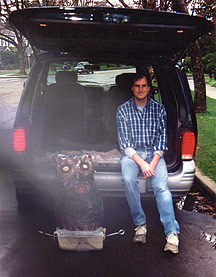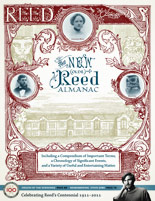
IRIS login | Reed College home Volume 90, No. 4: December 2011
In Memoriam
Prodigal Son
Steve Jobs [1955–2011]
By Chris Lydgate ’90

In the winter of 1996–97, a band of Reedies including Justin Campbell ’99 and Colin McCluney ’99 took the Doyle Owl on a road trip to California. On a whim, they stopped by Steve’s house in Palo Alto and rang the bell. They were floored when Steve emerged, admired the Owl, talked about Reed, and posed for this photo in Justin’s parents’ minivan. “He was really nice about it,” Justin says. photo courtesy of Jeremy Stone ’99
Visionary. Iconoclast. Rebel. Even though Steve Jobs was officially enrolled for just one semester, he was the quintessential Reedie.
It is far beyond the scope of this obituary to trace his protean career at Apple or assess his accomplishments and failures (and there were many of each). Classmates hardly need to be reminded of how he transformed the personal computer, the cell phone, and the music player, and how those devices in turn revolutionized a dozen industries.
But it is worth taking a closer look at Steve’s time on campus, because Reed was a much deeper part of him than one might think from his official transcript. In his crystalline intensity, his obsession with big ideas, his hunger for perfection, he personified the classic Reed archetype.
“Reed is about ideas, and Steve Jobs embodied the spirit of Reed by fighting to bring his ideas into existence,” President Colin Diver said after Steve’s death. “He revolutionized the way we communicate, how we listen to music, and how we share information. He showed us how the power of creative ideas can transform the world. We are saddened by his loss.”
Steve came to Reed in fall 1972. War raged in Vietnam. Bobby Fischer had just seized the world chess title from Boris Spassky. Watergate was smoldering. The counterculture was changing the face of higher education. Many colleges relaxed their academic standards and modernized their curriculum. Not Reed. As Tim Appelo ’78 wrote in the Hollywood Reporter:
At Stanford, any grade below a C was erased from students’ records. At Reed, there was no gentleman’s C, and you were expected to be too pure to even ask what your grades were. Your goal was perfection. It was all about questing individualism, original thinking, ruthless meritocracy. The school mascot was an image of burning ambition: a griffin blazing like the sun.
Steve was a brash 17-year-old from Palo Alto, California, from a family of relatively modest means. His father was a machinist; his mother an accountant. Steve lived on the third floor of Westport in room 32, a triple room at the end of the hall. Arriving before either of his roommates, he snagged the big central chamber. Even then he had outsized ambitions and a certain hauteur, according to his roommate, Eric Siegel ’76. He raved about the Beatles and Bob Dylan and dismissed organized sports as “fascist.”
Dorm dad Ron Luckerman ’73 remembers how Steve would come to his room late at night and pour out his heart about his romantic woes. Other times, Steve would stop by the pottery studio and give Ron a hand mixing clay and glaze. “Steve spoke with me more than any of the other dorm kids ever did,” Ron says. “Being younger may have had something to do with it.”
In the first couple of weeks of class, Steve Wozniak, a high school friend of Steve’s, showed up and crashed on the floor. Woz brought with him an early prototype of the “blue box,” a homemade hacking device that allowed the user to make free telephone calls. The blue box became an instant hit. Steve, Woz, and their friends would engage in pranks such as placing a call from a phone booth in Westport to Los Angeles, then to London, then Tokyo, Jakarta, Bombay, and back to Portland to the next booth over. Eric can still remember how the voice was delayed as the signal caromed around the globe. (On another occasion, Woz impersonated Henry Kissinger and placed a prank call to the Vatican, waking up the Pope. The pontiff’s reaction is not recorded.)
Woz made frequent trips from the Bay Area to Reed to see Steve, often lugging bags filled with electronic components; before long, Steve and Woz were manufacturing blue boxes in Westport. (Steve’s knack for marketing was apparent even then—he would fold slips of paper into the boxes with enigmatic messages, like Chinese fortune cookies. One read, “You’ve got the whole world in your hands.”)
This not-so-innocent experimentation nearly landed Steve in jail. At one point, Eric took a blue box to a phone booth outside the Rexall drugstore up the hill on Woodstock Boulevard. As Eric held the blue box to the receiver, he was arrested by FBI agents, who took him to a detention center and demanded to know where he got the device. “They told me, ‘You’re a history major. There’s no way you made this yourself,’” he remembers. Eric was just 17 years old but was not intimidated by his interrogators; he refused to roll over on Steve and Woz. Dean Jack Dudman ’42 [mathematics 1953–85] bailed him out. He was ultimately convicted and paid a hefty fine but, he says, “I never gave them up.”
![]()
Like many a freshman, Steve was intoxicated with the spirit of Reed, but intimidated by the curriculum. He took Hum 110, psychology, and philosophy, but was so focused on his own obsessions that he did not work hard on his studies—indeed, it is striking to note that none of his professors that first semester have strong memories of him. Feeling guilty about asking his parents to spend their savings on classes that he was only sporadically attending, he dropped out. As he later told the 2005 commencement class at Stanford, “It was pretty scary at the time, but looking back it was one of the best decisions I ever made. The minute I dropped out I could stop taking the required classes that didn’t interest me, and begin dropping in on the ones that looked interesting.”
Steve stuck around campus for another 18 months, auditing classes that would profoundly shape the way he looked at the world. A Shakespeare course from Charles Svitavsky [English 1961–98], for example, taught him about humanism and its ideals. A class in modern dance from Judy Massee [dance 1968–98] influenced his ideas on the perception of movement, which later proved invaluable in the design of animation routines.
But the most important course he audited at Reed was probably calligraphy from former Trappist monk Robert Palladino [art 1969–84]. “I learned about serif and san serif typefaces, about varying the amount of space between different letter combinations, about what makes great typography great,” Steve said later. “It was beautiful, historical, artistically subtle in a way that science can’t capture, and I found it fascinating. None of this had even a hope of any practical application in my life. But 10 years later, when we were designing the first Macintosh computer, it all came back to me. And we designed it all into the Mac.”
This period of Steve’s life was marked by intense curiosity and intense poverty. He slept on the floors of his friends’ dorm rooms. He scrounged meals in commons. He went barefoot. He recycled cans and bottles. “He had no money, no food,” says Eric. “I thought, this poor guy is never going to amount to anything.”
Nonetheless, Steve seemed to belong. “Reed was an open society with a strong sense of community,” says professor Ron Fial [psychology 1970–74]. “If you were willing to learn, you were considered part of that community.” In 1973, Steve asked Fial, who ran the psychology department’s workshop, if he could earn some extra money repairing circuits and equipment used in psychology experiments. “I knew about the blue boxes, and I knew he needed money,” Fial says. “He had the right skills, so we hired him.”
The part-time position gave Steve access to a workbench and a soldering iron—crucial tools during an era when many computing circuits were still constructed by wiring together individual components. Professor Bill Wiest [psychology 1961–95] remembers running into Steve in the basement of Eliot, where the workshop was located. “I’d walk in, and he’d have a project on the bench with switches and wires and circuits. He’d smile and say good morning, and we’d talk. He was always very polite, but was pretty vague about what he was actually doing—he’d just say he was just working on some experiments.”
Steve also forged a unique bond with Jack Dudman. “Dudman really liked him,” recalls one classmate. “He’d say, ‘That guy’s going to go places.’” Not only did Jack allow Steve to hang around campus, but he provided moral and financial support, even going so far as to slip a surreptitious $20 bill into Steve’s tattered coat pocket.


LATEST COMMENTS
steve-jobs-1976 I knew Steve Jobs when he was on the second floor of Quincy. (Fall...
Utnapishtim - 2 weeks ago
Prof. Mason Drukman [political science 1964–70] This is gold, pure gold. God bless, Prof. Drukman.
puredog - 1 month ago
virginia-davis-1965 Such a good friend & compatriot in the day of Satyricon...
czarchasm - 4 months ago
John Peara Baba 1990 John died of a broken heart from losing his mom and then his...
kodachrome - 7 months ago
Carol Sawyer 1962 Who wrote this obit? I'm writing something about Carol Sawyer...
MsLaurie Pepper - 8 months ago
William W. Wissman MAT 1969 ...and THREE sisters. Sabra, the oldest, Mary, the middle, and...
riclf - 10 months ago